If you’re a long-time reader of Never Ending Footsteps, you’ll already know that Dubrovnik holds a special place in my heart.
It was back in 2011, in fact, when a very nervous version of myself stepped on board a plane with a one-way ticket in hand. Yes, Dubrovnik was the very first destination of my Very Big Trip. My Big Trip that was initially supposed to last for 12 months but has somehow morphed into thirteen years of full-time travel!
Dubrovnik was where it all began.
Of course, I fell hard for this beautiful city, but how could I not? Dubrovnik is absolutely spectacular; so visually impressive and packed full of history and culture. I’ve returned here multiple times over the past decade and joyously watched as it transformed from a underrated destination into a tourism big-hitter.
Yes, the crowds can be intense at times (try to avoid visiting in August if at all possible) and prices have most definitely increased post-pandemic, but this is a destination that is still absolutely worth it. I even sent my parents here last year because I was so convinced they would love it — which they did. After all, there’s nowhere in the world like Dubrovnik. After so many trips to the Pearl of the Adriatic, I now feel perfectly placed to start writing about all of the best activities for first-time visitors.
Without further ado, then, here are the best things to do in Dubrovnik.
Walk Dubrovnik’s City Walls
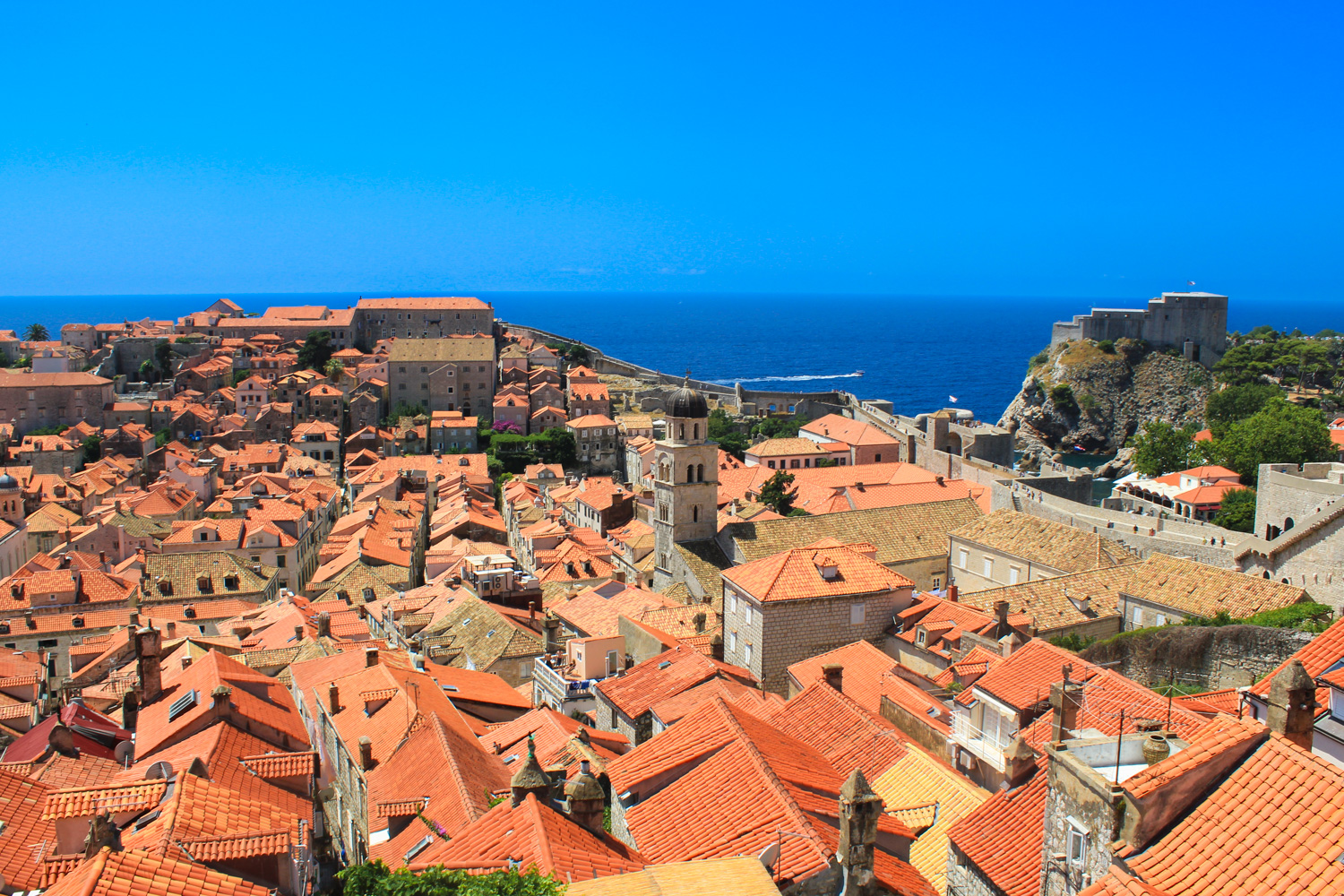
If there’s one thing that every visitor to Dubrovnik does, it’s walking the circumference of its old town.
Dubrovnik’s City Walls date back to the 9th century, while also including fortifications that were added during the 14th century. Either way, there’s no denying it: these walls are old. Despite this, they’re in remarkably good condition and part of the reason why the city gained its UNESCO World Heritage status.
The thick stone walls — measuring as wide as six metres in some parts — encompass the entirety of the city’s historical centre and give visitors the most impeccable birds’ eye view over the sea of terracotta roofs. Plus the actual sea, of course.
Now, there’s no denying that this is an expensive activity — potentially the most expensive one you’ll pay for on your visit — but it’s totally worth it. The views that you gain over Dubrovnik are unparalleled and the activity itself takes roughly two hours to complete. So, yes. To me, the eye-watering sum of €35 is genuinely worth it.
There’s no real need to buy your city walls tickets ahead of time, as there’s an unlimited number available each day — you can purchase them in person from the ticket office beside Pile Gate. Alternatively, you can buy your tickets online from the official website.
Do note that if you happen to be visiting Dubrovnik during its low season, between November and February, the city walls entrance is discounted down to €15!
My biggest travel tip? I recommend visiting the city walls at off-peak times in order to beat the crowds. It gets crowded up there at midday; so crowded, in fact, that it’s hard to move freely at times. That can ruin a travel experience, so instead, aim to be up on the city walls from the moment they’re open. In 2024, the opening times are:
- 8 a.m. (1st June – 15th September)
- 9 a.m. (16th September – 31st October and 1st March – 31st May)
- 10 a.m. (1st January – 29th February)
Visit the Cathedral and its Treasury
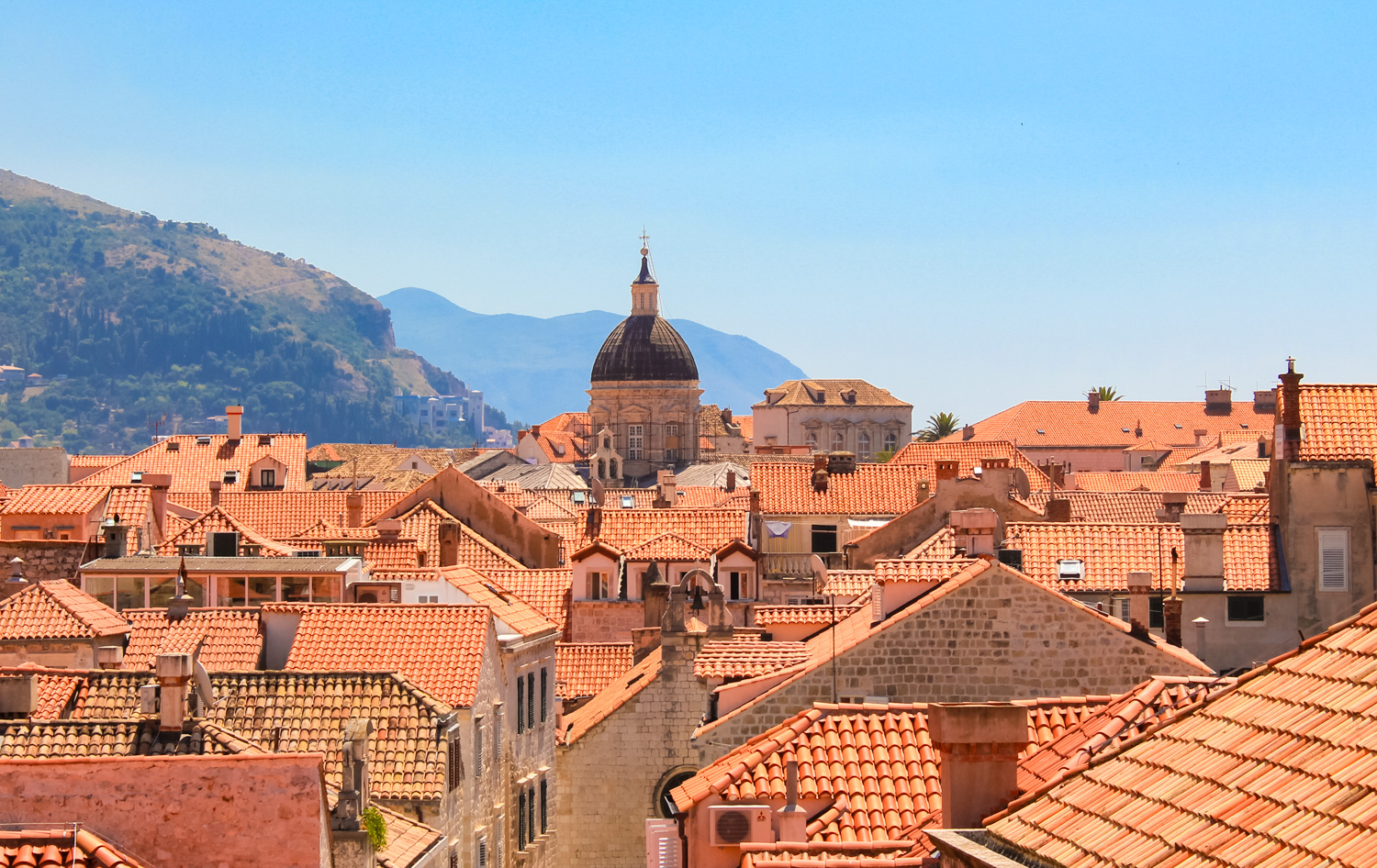
Designed in gorgeous baroque style, the Cathedral of the Assumption of the Virgin Mary is a brilliant part of Dubrovnik’s cityscape. After the original church, built in the 6th century, was destroyed by a series of devastating earthquakes, this one took its place.
Famed for its polygonal recess with a domed roof, the church has an interior that matches its breathtaking construction. Visitors can explore the three aisles, and the recess with the highlights being the number of historic paintings from the 16th to the 18th centuries.
No time in the Cathedral would be complete without visiting the Treasury. Harboring many ancient artefacts, most notably a part of the cross on which Jesus is believed to have been crucified. In addition, you’ll find over 100 holy relics of gold and silver from all around the world.
Stroll the Stradun and Take Your Photos
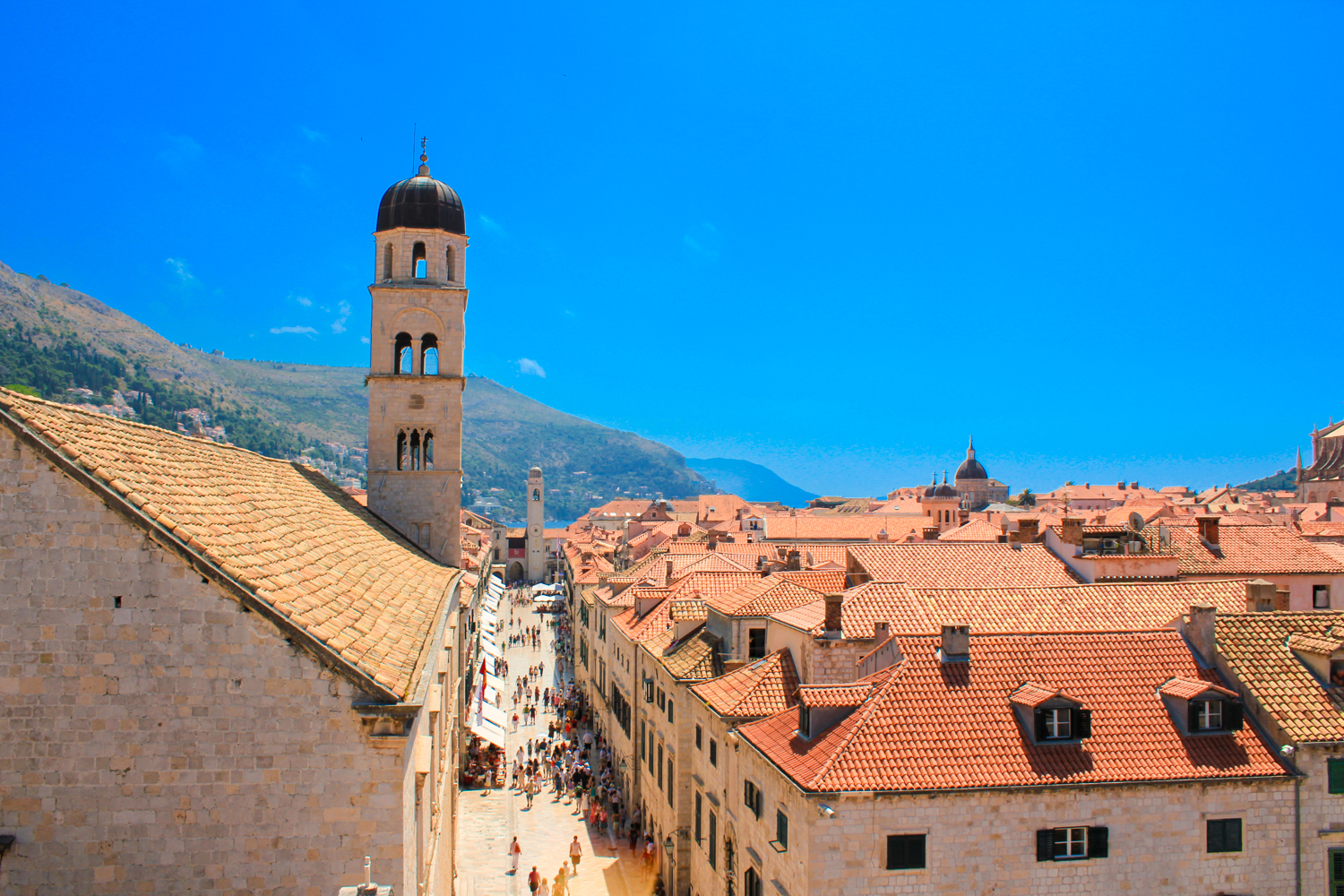
After a slice of Dubrovnik’s long history, it’s time to take in some culture. One of the best things to do in Dubrovnik is to walk down the Stradun. Known locally as the Placa, the Stradun is one of the most stunning pedestrian streets in all of Europe.
A popular gathering place of Dubrovnikans, this is the perfect spot for some people watching and a glimpse into local life. The street is short but sweet, full of interesting architecture and lined with vibrant cafes and restaurants. It’s also a top spot to take part in some shopping.
As you wander down the happening Stradun, you may notice the residential buildings being symmetrical. Anyone of us with even slight OCD will love how each door and window in the street is perfectly in line with the other. After enjoying a smooth espresso, hit up the War Photo Limited museum.
People-Watch in Loggia Square
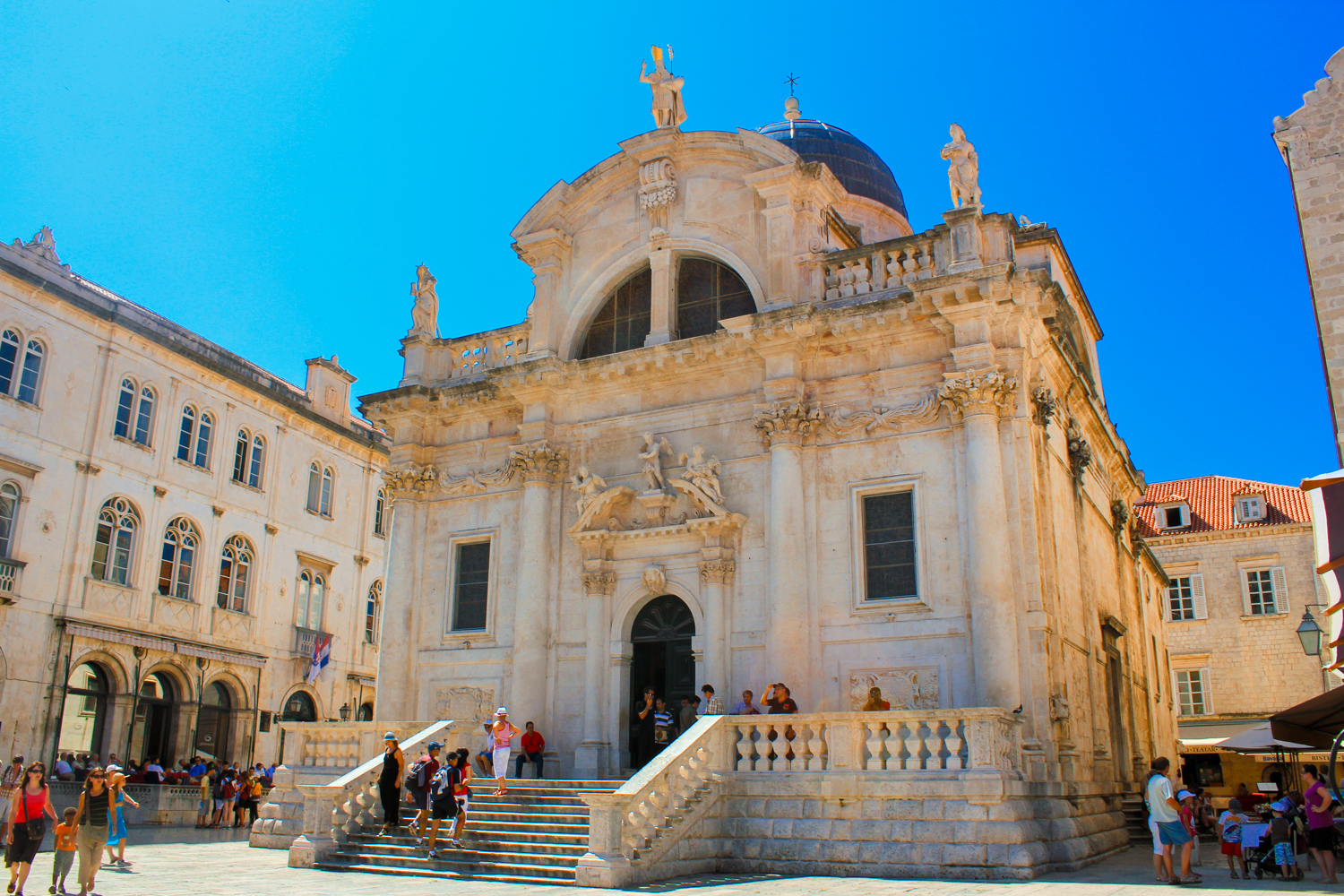
Like the Stradun, a great way to capture life in Dubrovnik is to find a comfy spot in Loggia Square and watch the world go by. In the northern section of the Old City, the square is home to some of the most historic and iconic buildings in Dubrovnik.
As you’re watching the locals go about their day-to-day, you’ll be able to spot up the Church of St Blaise, Onofrio fountain, and Orlando’s Column. The chief attraction in Loggia Square, however, is the Loggia of the Bells. Built in 1480, the bells were used as a warning for the community that danger was afoot.
Named after Dubrovnik’s patron saint, the Church of St Blaise known for its Venetian design. Wander inside to bask in the stunning interior with impeccable designs. Continue along, passing a beautiful collection of art until you reach the altar, the highlight of the church’s interior.
Outside of the Church of St. Blaise is Orlando’s Column. The statue and flagpole date back to the 15th century and is a common gathering point in the Placa.
Orlando is a medieval knight that helped defend the city during a 15-month siege during the 800s. With his help, Dubrovnik was able to once again be a city of free trade. Notably, Orlando’s Column is a prominent example of the Dubrovnik’s freedom. When the Summer Festival is on, the column’s mast will raise the Libertas flag.
The City Gates
Dubrovnik’s Old Tow is only accessible through one of the city’s iconic gates. There are two ways to enter but the most exciting way is through the pedestrian-only Pile Gate. Constructed in the early 16th century.
Featuring a drawbridge which helped arrivals cross the moat (now a delightful garden) and into the city, walking through the stone arch is the perfect way to jump back 500 years and complete your dream of being a knight. On the other side of Pile Gate is a sculpture of St. Blaise, with the rest of Lapad now open to explore.
Other prominent gates in Dubrovnik include the Ploce Gate from the 14th century. You can find this gate at the Asimov Tower.
Go on a Game of Thrones Tour
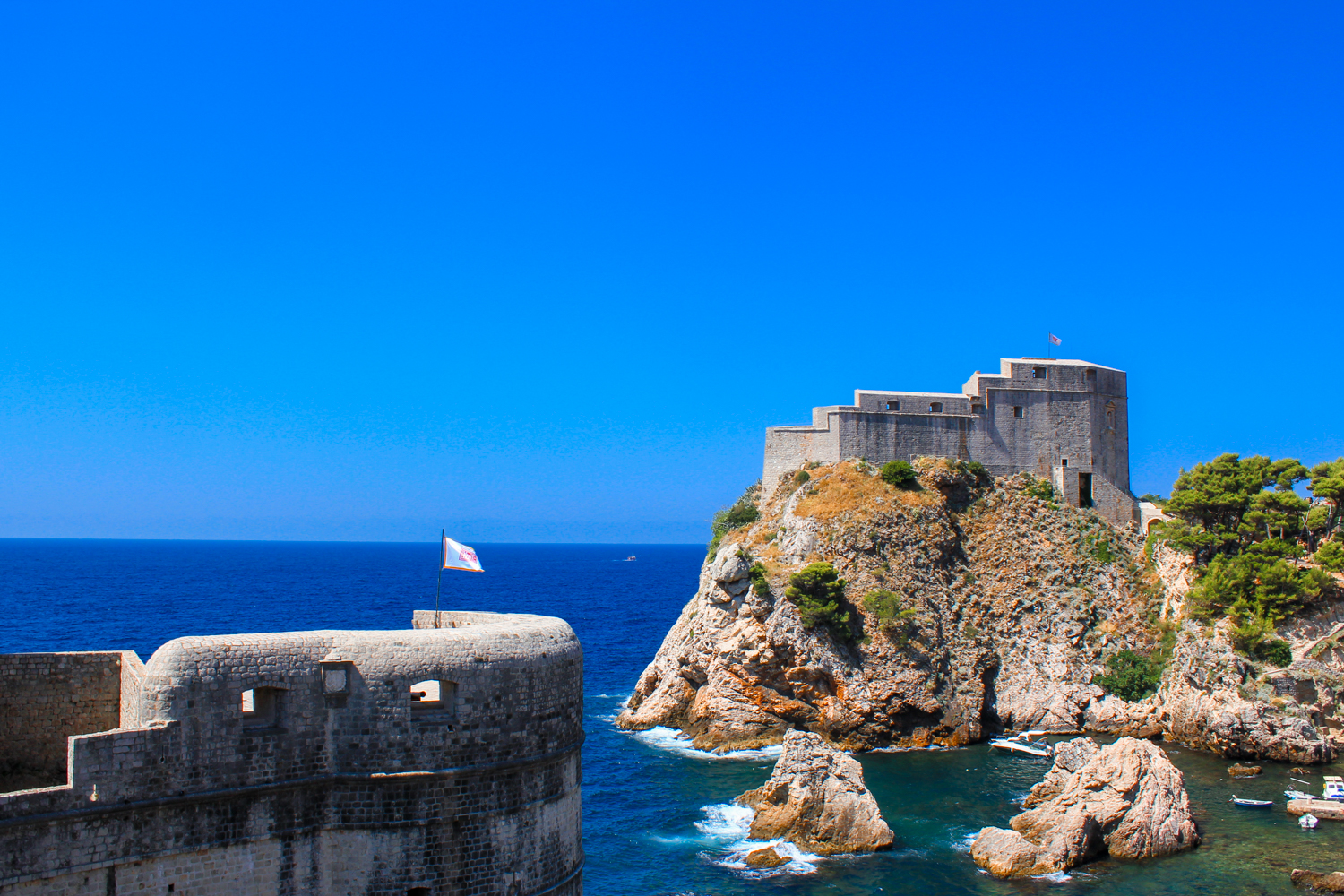
Dubrovnik, and Croatia at large, is home to some of the most renowned filming locations for the show. A huge part of what made the show captivate a worldwide audience was some of the amazing historical places where the director could shout, “action!”
What should excited any GOT fan is how accessible many of these locations are. In fact, if you’ve already roamed Dubrovnik’s Old Town and the City Walls, you would have recognized many locations from your TV screens. King’s Landing is based upon the Old Town, while you can also stand upon Blackwater Bay and see the place where King Joffrey’s infamous wedding took place.
Visit all the top filming locations with an expert guide on this highly rated Game of Thrones tour. Other filming locations for the Game of Thrones in Croatia include Mereen (Split) and the Unsullied scenes in Sibenik.
Visit Lokrum
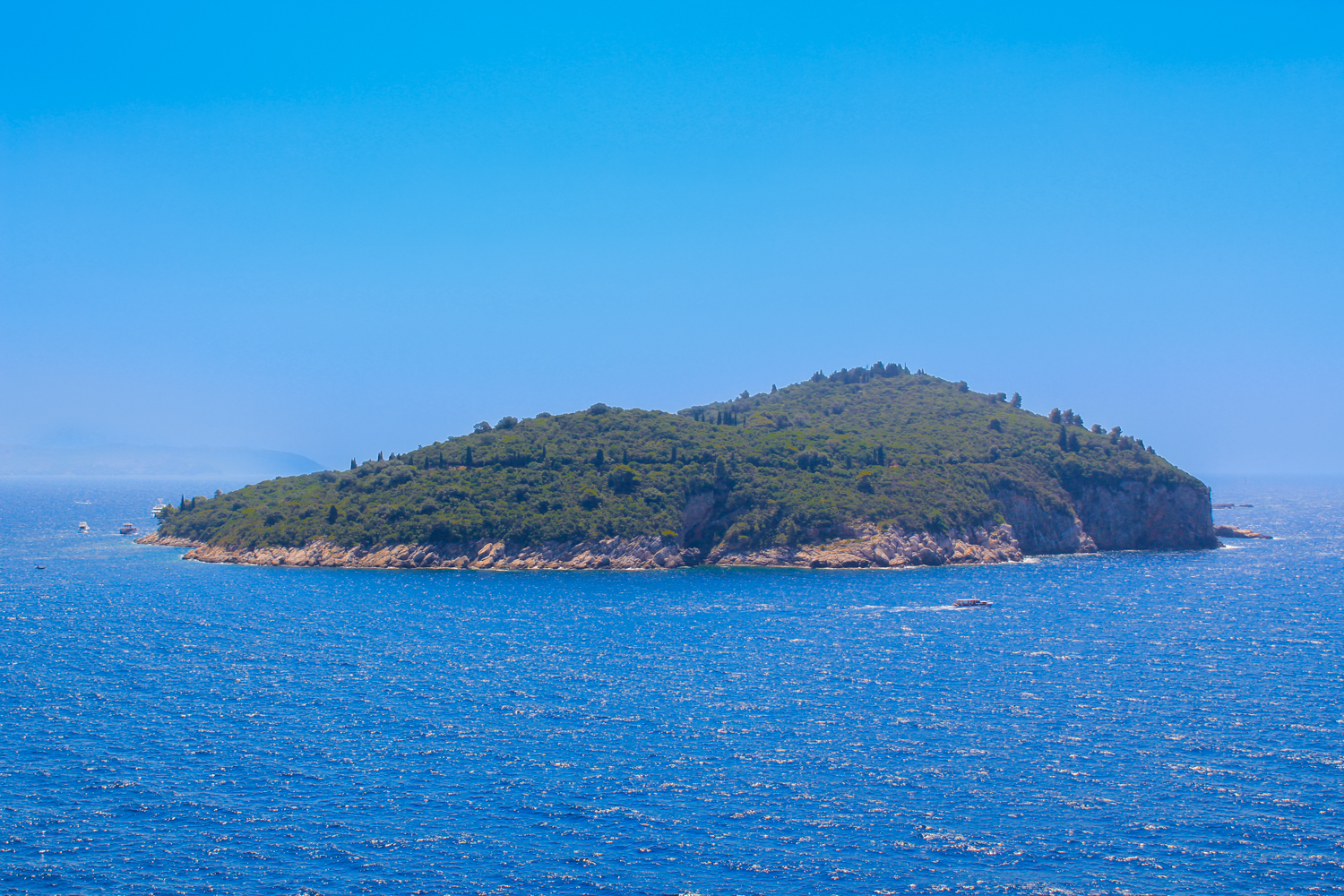
After some time spent exploring the narrow streets and ancient buildings, enjoy some time just outside of the city. From Dubrovnik’s Old Port, you can catch a ferry to Lokrum Island just a few minutes away.
The must-see island will perfectly complement your adventures in the city. Here, the only full-time residents you’ll come across are the local peacocks. After leaving a man-made paradise, travelers will find themselves in a natural one, with sprawling interior saltwater lakes, botanical gardens and one of the many nudist beaches in Croatia.
But Lokrum isn’t all dense forest and turquoise water. You’ll also find a spectacular 11th century Benedictine monastery along with the Fort Royal Castle, built under the orders of Napoleon. You can hike to the castle, take a water taxi to the monastery or explore the lake on a kayak.
Fountain of Onofrio and St. Saviour Church
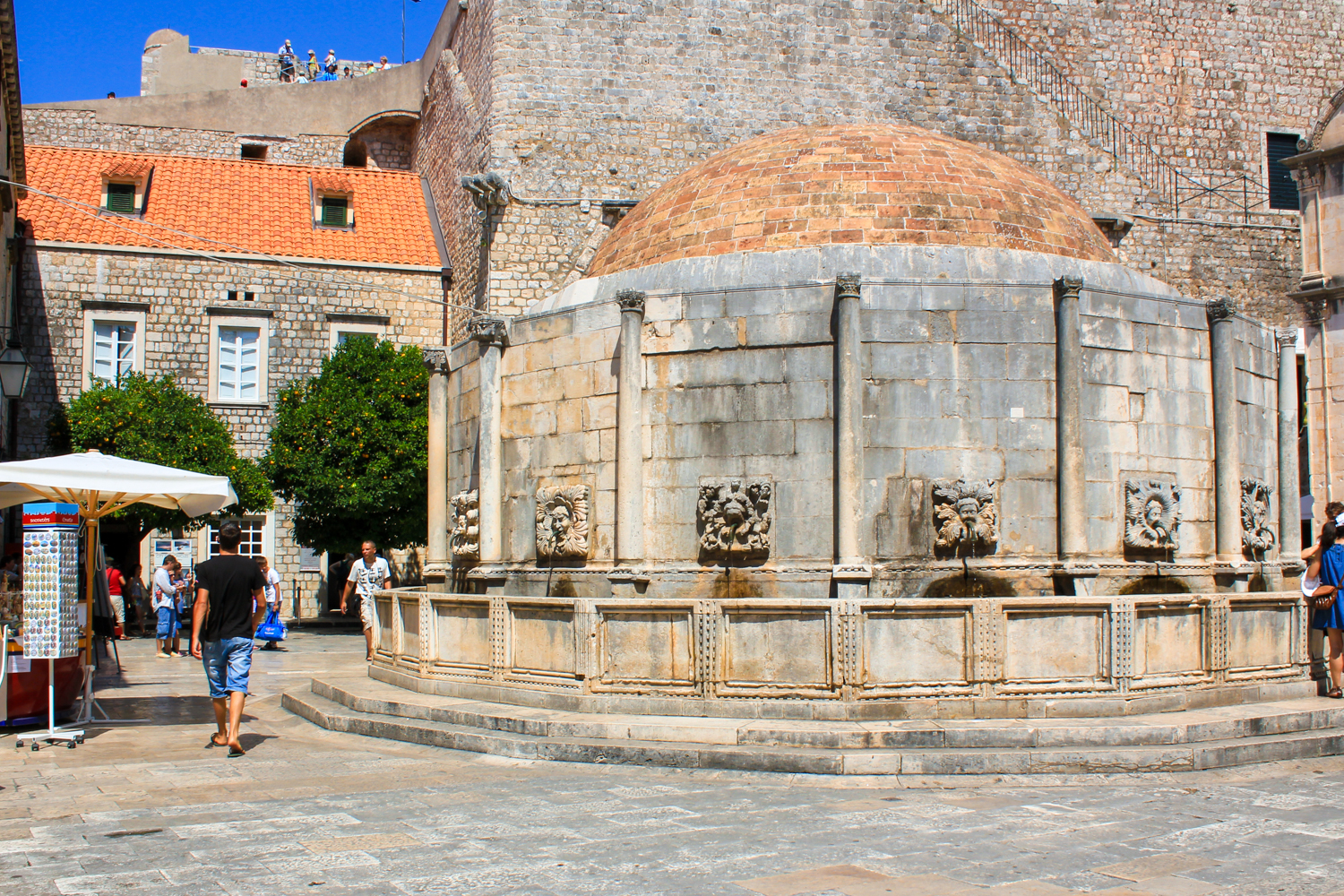
A list of the best things to do in Dubrovnik wouldn’t be complete without one of the city’s most renowned landmarks. Built in the 1440s, you can visit the Large Fountain of Onofrio after passing through Pile Gate. The fountain played an important role in delivering water to local residents from the Dubrovacka River.
The large fountain was damaged during the earthquake of 1667 and is small today, however, its aura hasn’t been diminished. After gawking at the beautiful fountain, lift your eyes to see beautiful St. Saviour Church right behind Onofrio.
The church opened in the 1500s as a way to pay thanks after divine intervention prevented an earthquake from affecting Dubrovnik in the years prior. Rather poignantly, the St. Saviour Church later survived the major earthquake of 1667.
The Fort of St. John
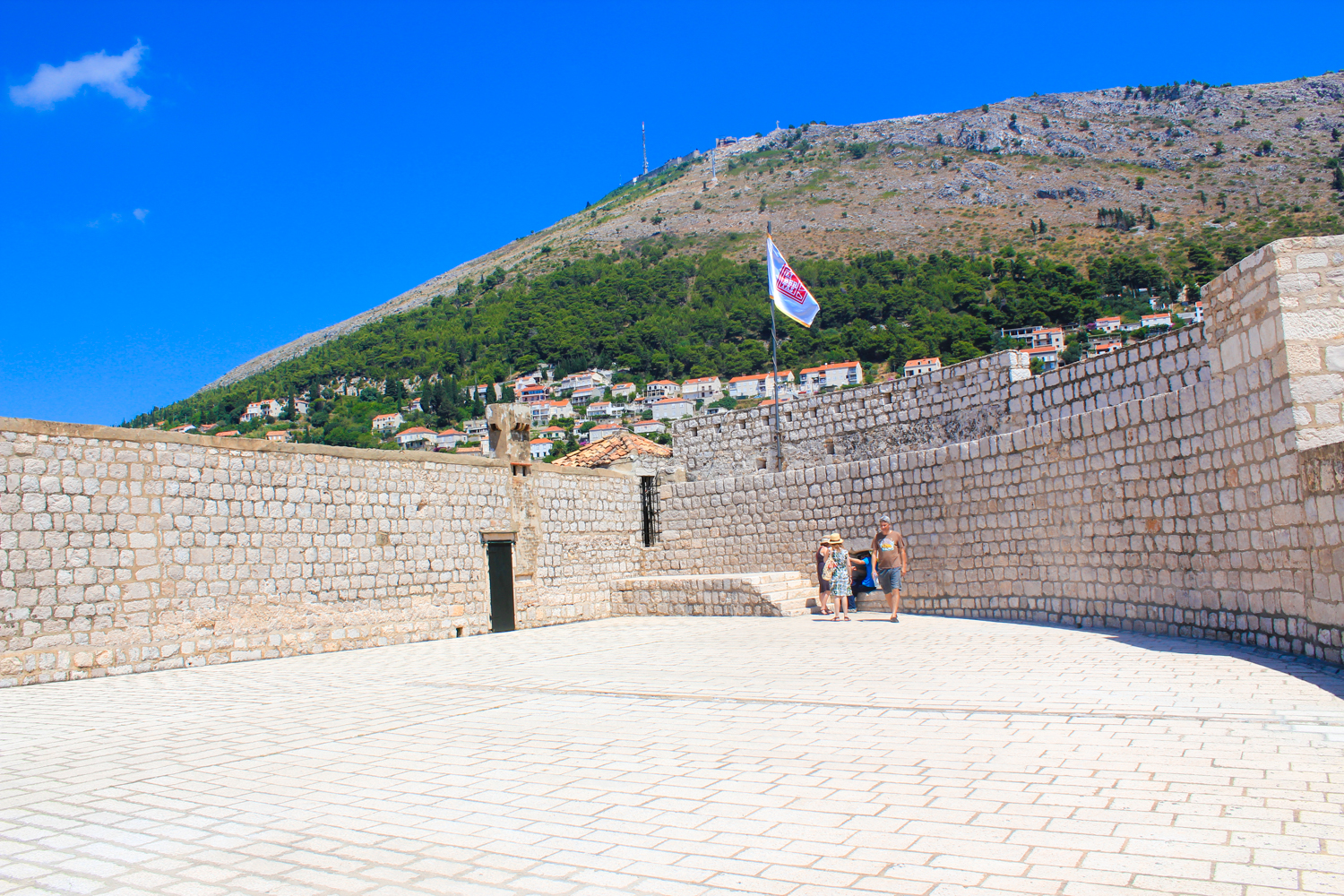
As you walk the City Walls, you will pass this fort, which once played a prominent role in the defense of Dubrovnik. The Fort of St. John helped to protect the port and the Old Town from pirate raids. Aside from being the lookout, the fort had a giant metal chain that connected to Kase Jetty.
When enemy ships arrived, they would raise the chain to damage and stop the ships in place. Today, the Fort of St. John is home to several attractions that will make you pause your journey along the ways. Pay a visit to the Maritime Museum which explores the city’s history at sea from model ships to historic artifacts. You can also stop by the aquarium, one of the top things to do in Dubrovnik with kids.
Sun Bake on Banje Beach
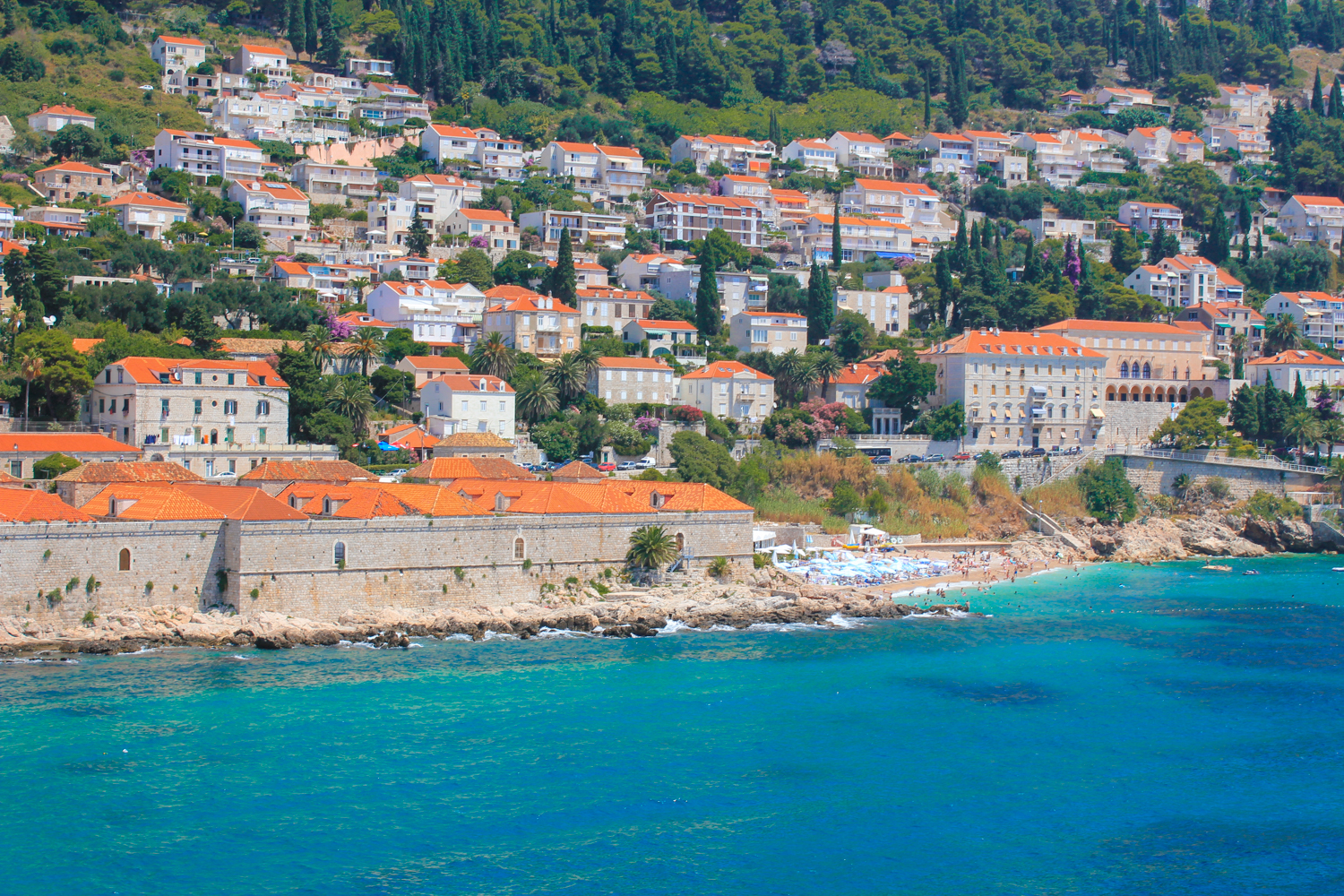
Beyond sightseeing, Croatia’s storybook Dalmatian Coast and the Adriatic Sea are a huge reason travelers book a flight here. One of the best beaches in the country can be found right here in Dubrovnik, Banje Beach. Fun, relaxing and downright easy on the eyes, the beach is a great way to kick back and take a break from the urban adventures.
If you’ve come in the warmer months, you’ll want to chance to cool off. The calm and crystal clear waters of Banje Beach are great for young and old to wade in. You can also venture out on SUPs or in a sea kayak to explore the coastline. Behind the beach are a series of top line restaurants and seaside bars. Stick around for golden hour to experience one of the best places to see the sunset in Dubrovnik.
Ride the Cable Car
In a city of colorful coastlines and tangerine roofs, the best way to see it all is from above. For the best view in Dubrovnik, head to the top of Mount Srd, which stands 1350ft (412m) above the cityscape. In the peak summer months, the cable car, which first ran in 1969, runs until midnight.
This provides visitors with a range of times to enjoy the amazing views. During the day, look down upon the clay-topped buildings and see the turquoise water lap the edge of Dubrovnik. But facing west across the Adriatic Sea, head up in the evening and watch the sun fall below the western horizon.
From the top of the 10-minute ride, it’s not just the view that you have to look forward to. Check out the Imperial Fortress home to the Homeland War Museum (listed below), the blacksmith shop, or dine with a view at Restaurant Panorama.
Lovrijenac Fort
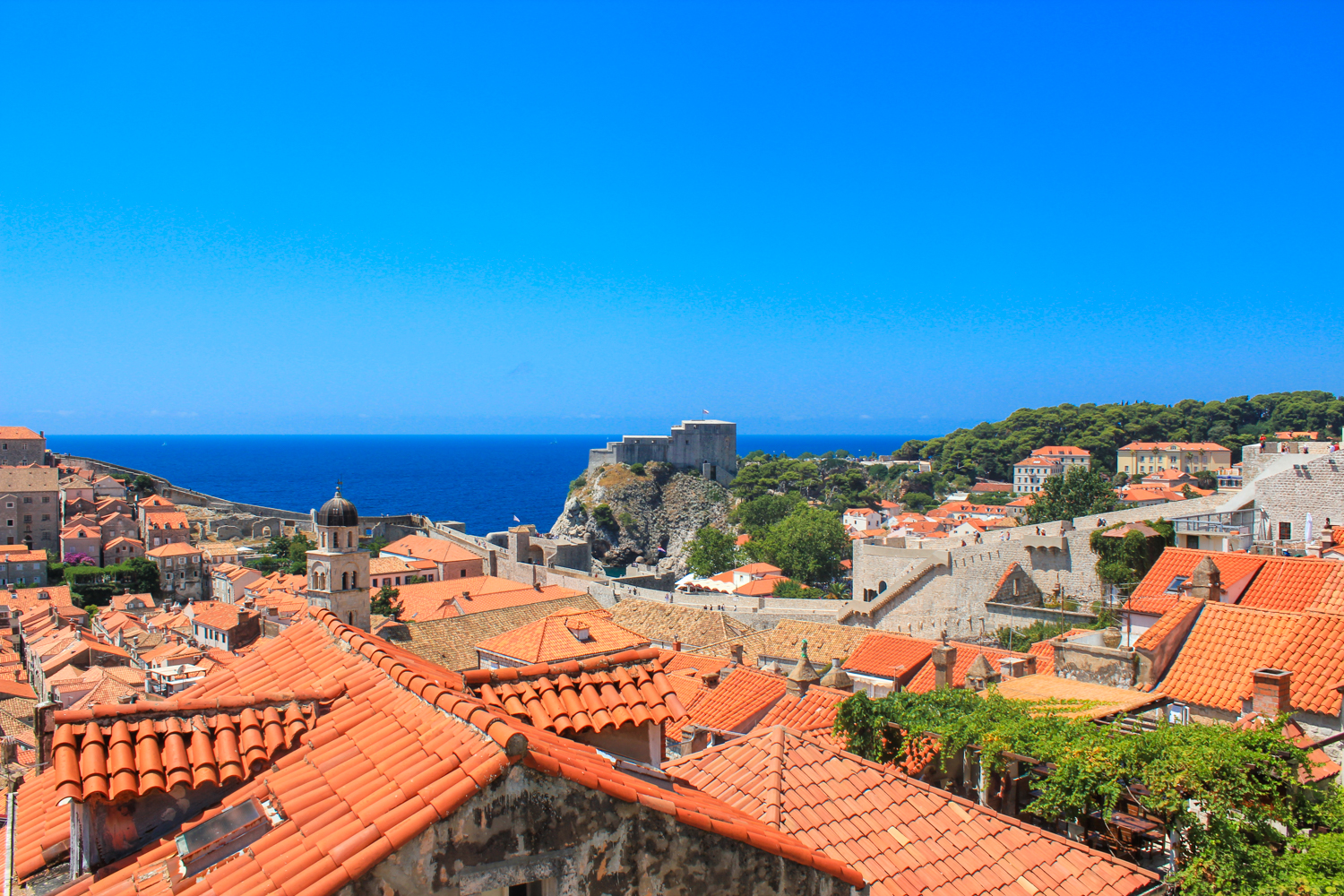
An important fortress throughout the history of Dubrovnik, the Lovrijenac Fort, proved to be impenetrable, stopping attack after attack in its tracks. Found just beyond the western edge of the City Walls, the fortress rises 120ft (37m) and looms ominously over the coast.
The unique design of the fort, which its triangular layout, protected the city from multiple Venetian advances. Helping the local army was the fort’s walls, which were up to 40ft (12m) thick in certain places. Ironically, the Venetian forces had hoped to construct their own fort here only for the residents of Dubrovnik to build one within 3 months.
Head to the top of Lovrijenac Fort for impressive views, while the fort is always home to a summertime rendition of Shakespeare’s Hamlet.
The Red History Museum
From 1945 to 1991, Croatia was under the communist rule of the Yugoslav federation. The Red History Museum explores this period in the nation’s history, which ended with the Homeland War. Impressively, the museum began thanks to a group of friends who managed to create a captivating series of displays backed by dozens of prominent artefacts.
The Red History Museum offers an insight not just into the events but also the ideals of the regime and how that affected local life. Sit on furniture from the period, comb books and magazines and use your smartphone to interact with various exhibits.
Roam the Franciscan Monastery
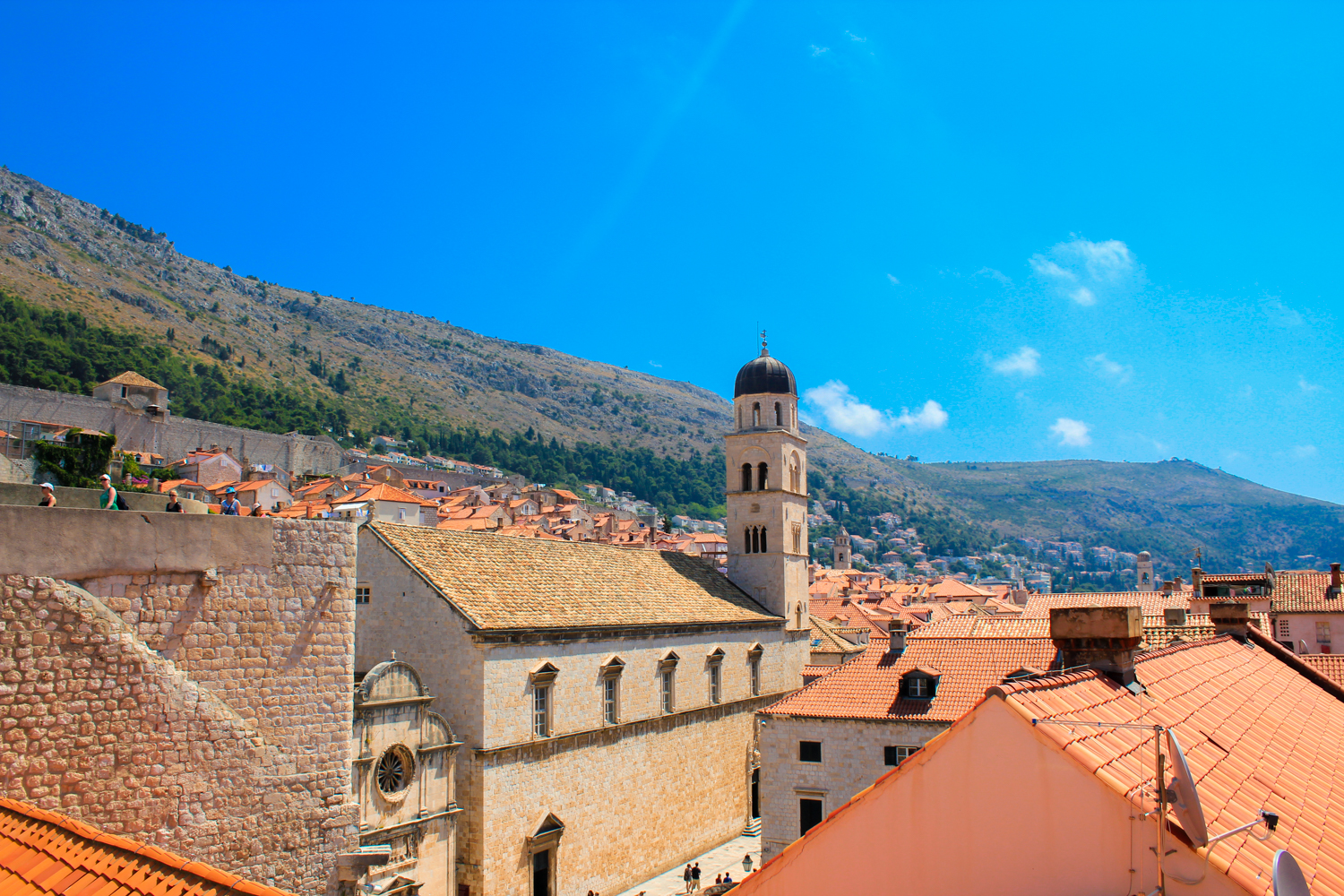
Along the Stradun and next to the main entrance to the City Walls, is the Franciscan Monastery. The entrance to the monastery can be hard to spot lurking around the corner from Pile Gate. But upon entering the Franciscan Monastery, you’ll quickly leave behind the often boisterous Old Town.
Within the walls of the monastery, first built in the 14th century, is one of the oldest pharmacies in the world. Peruse the mortars and jars just as they were in 1317 when they first welcomed the town’s residents. Another highlight here is the library built in the 1600s. The library is home to over 20,000 books and rare scripts.
Finish up your time at the Franciscan Monastery by visiting the museum that covers the history of the site, complemented by a wonderful collection of fine art.
Explore the Trsteno Arboretum
On your Game of Thrones Tour you would have explored the Trsteno Arboretum, home of the Red Keep. However, if you’re not a GOT fan but enjoy stunning gardens, then you should definitely add this to your Dubrovnik itinerary.
Dating back to at least the 1490s, the pristine landscapes were once home to the Gozze Family and are a delightful example of Renaissance-era gardening. The arboretum began as sea captains would return home from far-off adventures with exotic plants. The result? Trsteno is the oldest arboretum on earth.
Just outside of the busy downtown, the gardens also provide a welcoming escape from the bustle. Explore the nature and find a slice of peace topped off with a beautiful grotto and baroque fountain.
Kayak the Dalmatian Coast
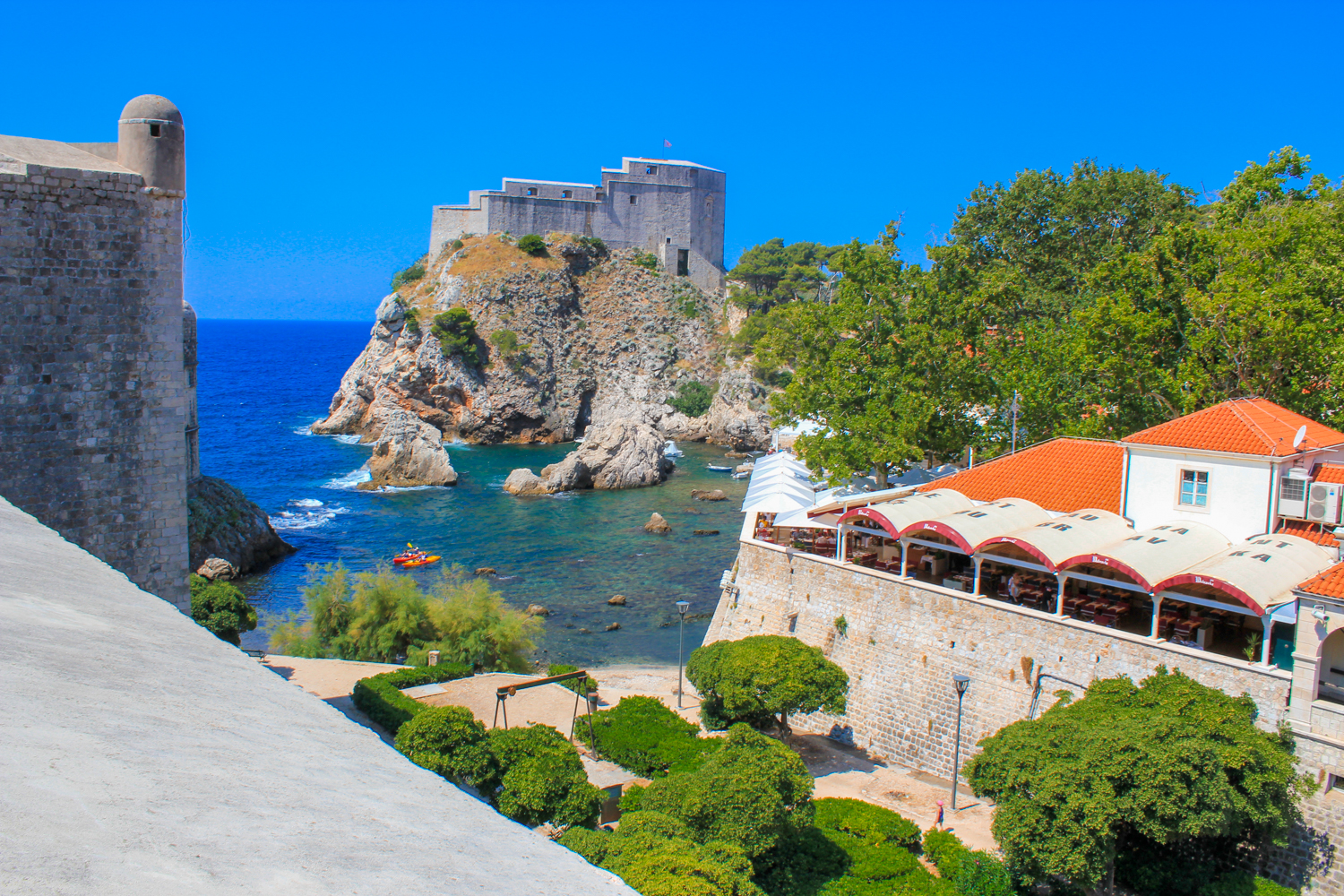
Dubrovnik’s picturesque Dalmatian Coast, dotted with golden beaches and historic forts, is best explored on kayak. After some relaxing afternoons soaking in the Adriatic sun, enjoy a paddle and a different perspective of the ancient city.
On this guided tour, you can admire the City Walls from the other side of the stone. Beginning at Banje Beach with a quiet tutorial, follow your expert guide and learn more about Dubrovnik’s fascinating history while floating on crystal clear waters.
Later, paddle over to Lokrum Island to complete two fun things to do, for the price of one. Pop on your snorkel gear and swim through Betina Cave, admiring the marine life beneath the surface.
Escape to Elafiti Islands
One of the best day trips from Dubrovnik involves the exciting journey to the Elafiti Islands. After some time exploring Lokrum, you may be inspired to see what else is right off the coast. Thankfully, the six islands in Elafiti’s mini archipelago offer the perfect escape from the city.
Providing a different atmosphere to Dubrovnik, two of the islands are completely car-free. The most popular destination is the stunning settlement of Lopud. With fort ruins overlooking the city, and ample exotic gardens to explore, wander the narrow streets to discover ancient monasteries before settling on one of the pristine local beaches.
Other popular locations include the dense pine forests of Kolocep, including the olive groves and orange orchids along with the larger island of Sipan. The Elafiti Islands can all be reached via ferry, which runs regularly through the day.
Enjoy a Food and Wine Tour

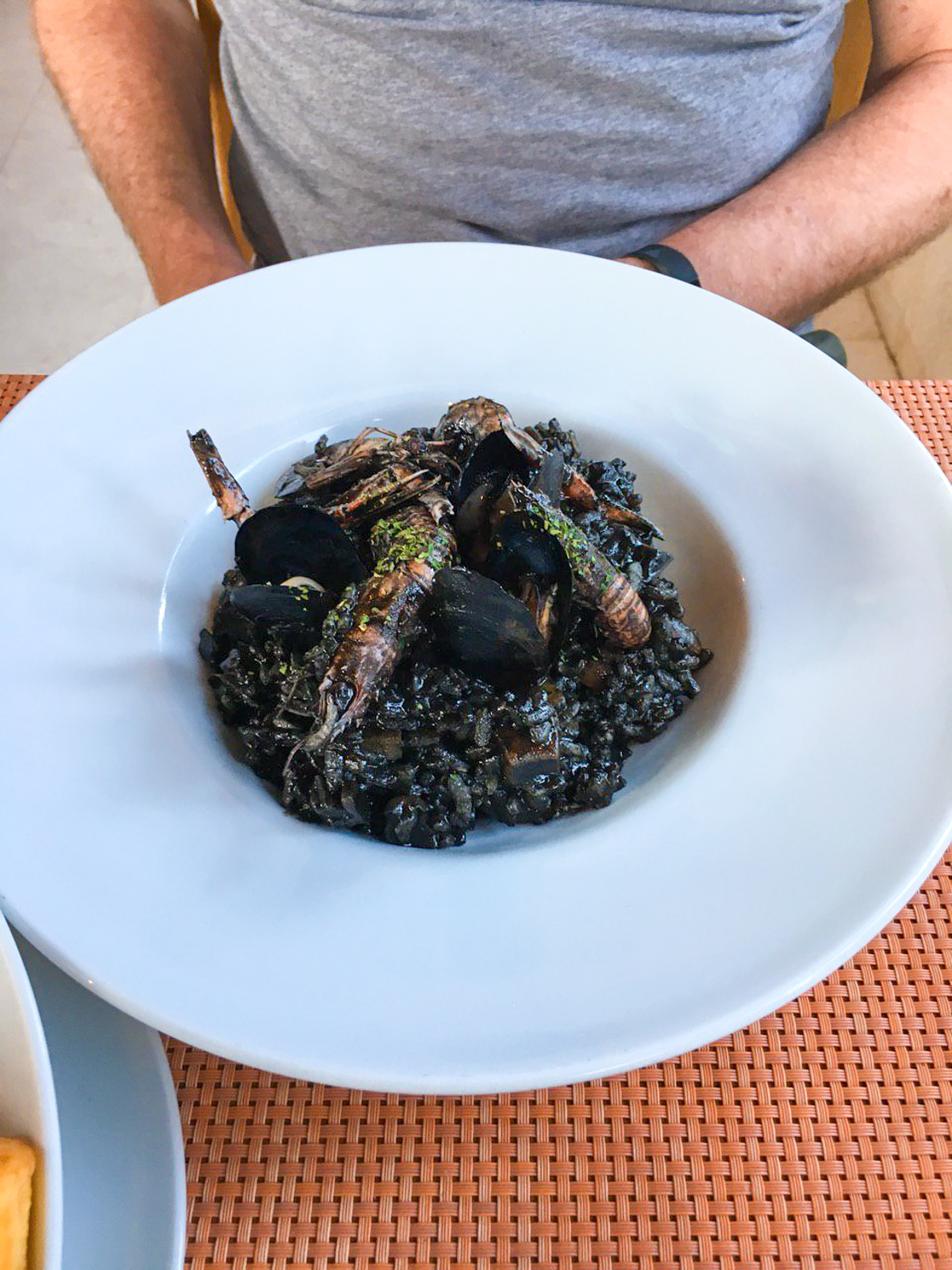
With history and architecture around every corner, it’s easy to overlook the amazing restaurants and bars that now call those buildings home. Once you feel you have a solid understanding of Dubrovnik’s heritage, it’s time to dive into the modern culture of this incredible city.
The seafood in Dubrovnik is amazing! In my photos above, you can see two of my favourite meals in the city: a fried seafood medley and a cuttlefish risotto. Both were so good and so fresh!
On this food and wine tour, immerse yourself in the dining scene found in Old Town. Wander the cobblestone streets with from a different perspective, seeing the amazing sights but now thinking about the delicious eats that await.
Over the course of three hours, try the local specialties and tasty treats, all the while sampling some of the best wines produce in the region and around Croatia.
Climb the Jesuit Stairs
Similar to Rome’s Spanish Steps, the Jesuit Stairs is a beautiful example of baroque designs and one of the top sights in the Old Town. The stairs were complete in 1738 and connects visitors between St Ignatius Church and Gundulic Square.
While climbing the stairs offers some splendid views of the streets below, the base of the Jesuit Stairs is the spot of a popular local market. With local produce and wares brought in from neighboring towns, shop for interesting trinkets or pick up some tasty treats.
Visit Rector’s Palace
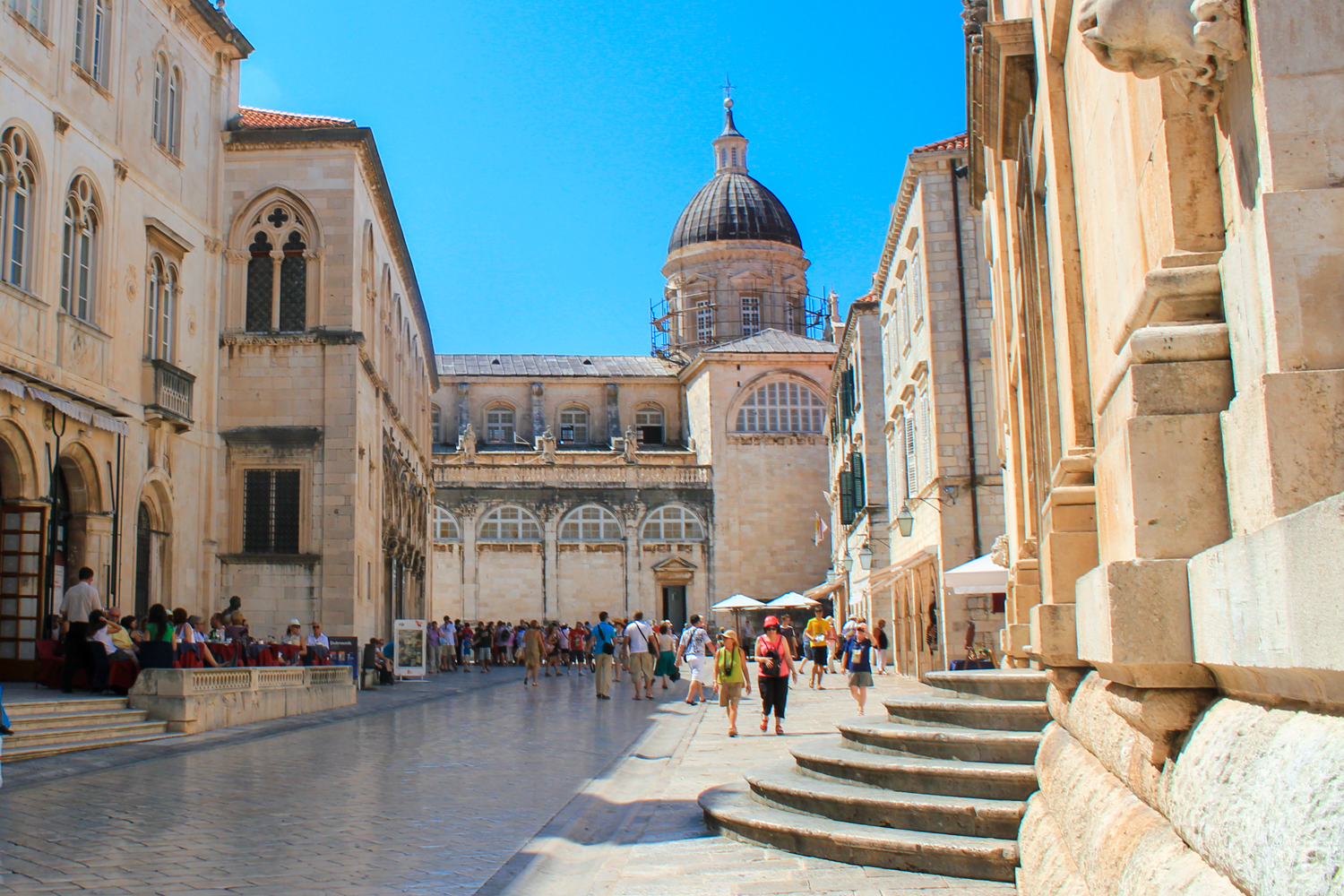
Home to Dubrovnik’s Cultural Historical Museum, Rector’s Palace is a stunning piece of architecture that dates back to the early 1500s. Altered and fixed through the eras, thanks to explosions and earthquakes, the palace now features a mix of Renaissance and Gothic designs.
Today, you can explore the beautiful courtyard placed centrally within the palace. In the summer, the courtyard is home to several live classical performances befitting of such a location.
With the museum is an array of artifacts that cover much of Dubrovnik’s history, including a detail insight into the Medieval Era. Plus, take in many historic artworks from the Renaissance.
Homeland War Museum
After arriving via the cable car, explore the peak of Mount Srd before making your way to the Homeland War Museum. Dedicated to the siege of Dubrovnik during the Balkans War, visitors can expect an interesting look into the city’s history that is more recent than most would think.
The siege occurred between October 1991 and May the following year. You can explore the large exposition that covers the dark period, including important maps, weapons and artefacts. These are all complemented by a vast collection of photographs and multimedia displays.
From the museum, you can explore the inside of Fort Imperial, which played a major role in the city’s defence. Here you can also enjoy expansive views of Dubrovnik.
Take a Day Trip to Montenegro
Just two hours from Dubrovnik is the wonderful country of Montenegro. Offering a magical beauty to rival your local travels, experience mesmerizing scenery and delightful villages packed into a metaphorical pocket.
Popular places to visit include Budva, a medieval beach town complete with clay-roofed villages, and the historic walled city of Kotor. Here you can discover the Bay of Kotor home to the southernmost fjord in all of Europe.
If you’re up for exploring the mountains that soar out of the local waters, then make your way to Dumitor National Park for hiking, biking, rafting and skiing in the winter.
Have a Drink at the Cliff Bars
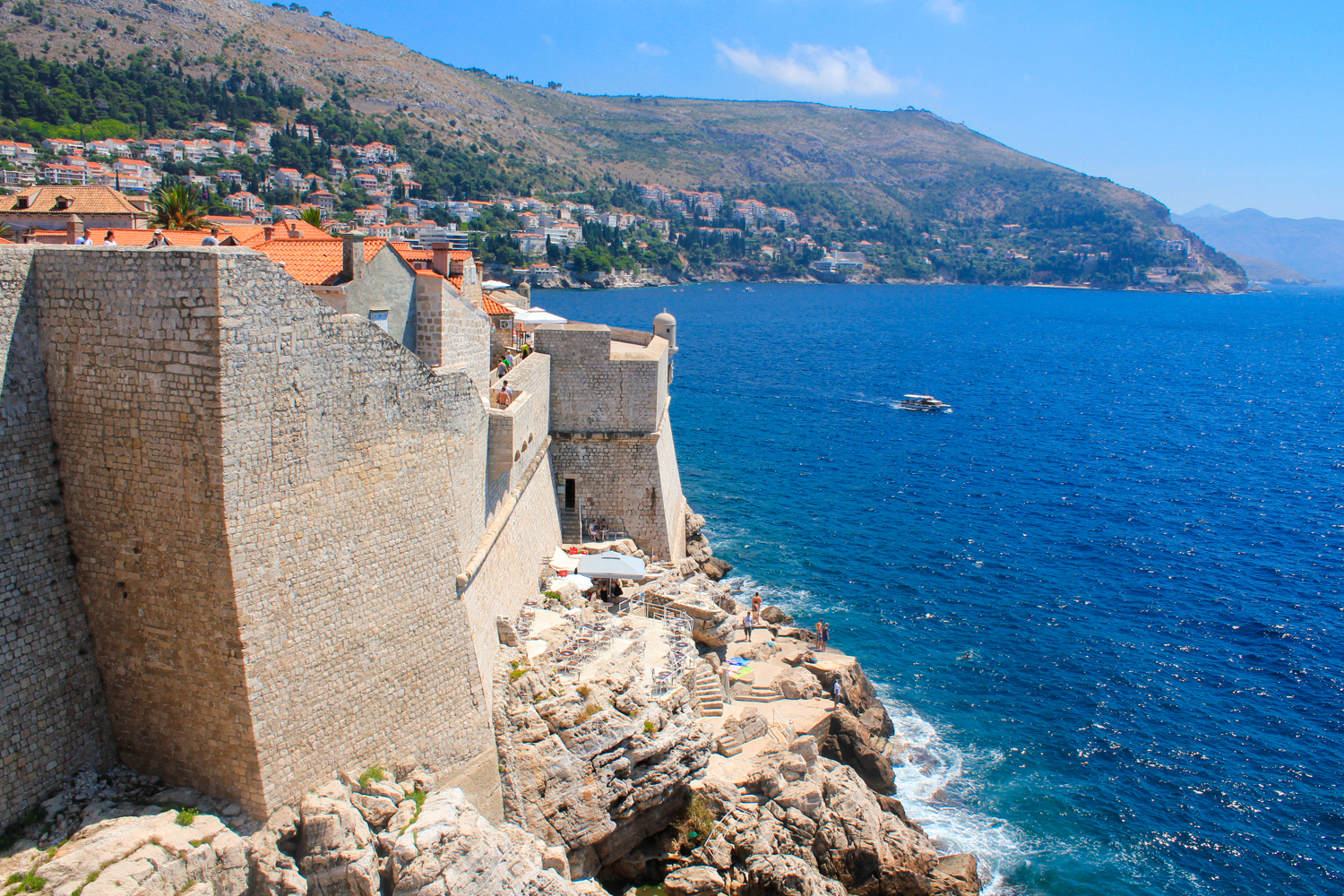
Set upon panoramic terraces away from the noise of downtown, there’s no better way to end your day in Dubrovnik than at the many cliff bars. With the waves of the Adriatic crashing against the City Walls beneath you, sip on a delightful cocktail at Buza Bar.
With easy access to and from the sea below, enjoy a swim before settling in or take a dip once the cocktail glass runs dry. But, of course, be seated for what promises to be an entrancing view of the sunset.
Enjoy an Outdoor Movie
If you’ve enjoyed a few evenings in the local bars, then you may want to switch things up. So why not wander into Old Town and watch a movie while surrounded by ancient stone buildings?
Run by the city council, Jadran Cinema provides guests with English-speaking outdoor films all summer long. Offering a great selection of indie films from around the world, along with Hollywood blockbusters, sit back under the stars and watch the action.
Also found here is a selection of live performances from theater to music. The renowned Lindo folklore band performs (and delights) crowds twice every week.
Shop at the Farmers Market
It should come as no surprise that the city’s farmers market is, well, ancient. Set within Gunduliceva Poljana, a baroque square, you can browse the aisle selecting delicious fruits, vegies and dried treats. One item not to miss is the homemade travarica, a flavored brandy with a powerful hit. You may not be a fan, but it’s the only place you can get your hands on it.
Saturday is the day everyone in town shops. So if you want to get some goods stowed away, arrive early. Otherwise take in the atmosphere at the market, which continues to grow throughout the morning.
Before noon, things start to slow down. At midday, the clock strikes, ending the market and attracting hundreds of pigeons to the area. In fact, they’ve arrived to feast on the grain provided by locals at the same time every day.
Go for a Sail
We’ve mentioned kayaks and spoke about ferry rides, but there’s no more memorable way to get out on the Adriatic Sea and explore the coast than on your very own boat. Croatia is famous for its Yacht and Sail Week (yes, they’re different) and with such great weather, there’s rarely a bad time to raise the sails.
You can trade in your ferry ride to the Elafiti Islands with an eight-hour yacht cruise. Simply jump off the starboard side for immediate snorkeling in the turquoise waters or take helm and learn how to guide your very own yacht from island to island.
Facing west, Dubrovnik experiences world-class sunsets. Experience the vast array of colors on the water for a romantic evening with your loved one.
Dominican Monastery
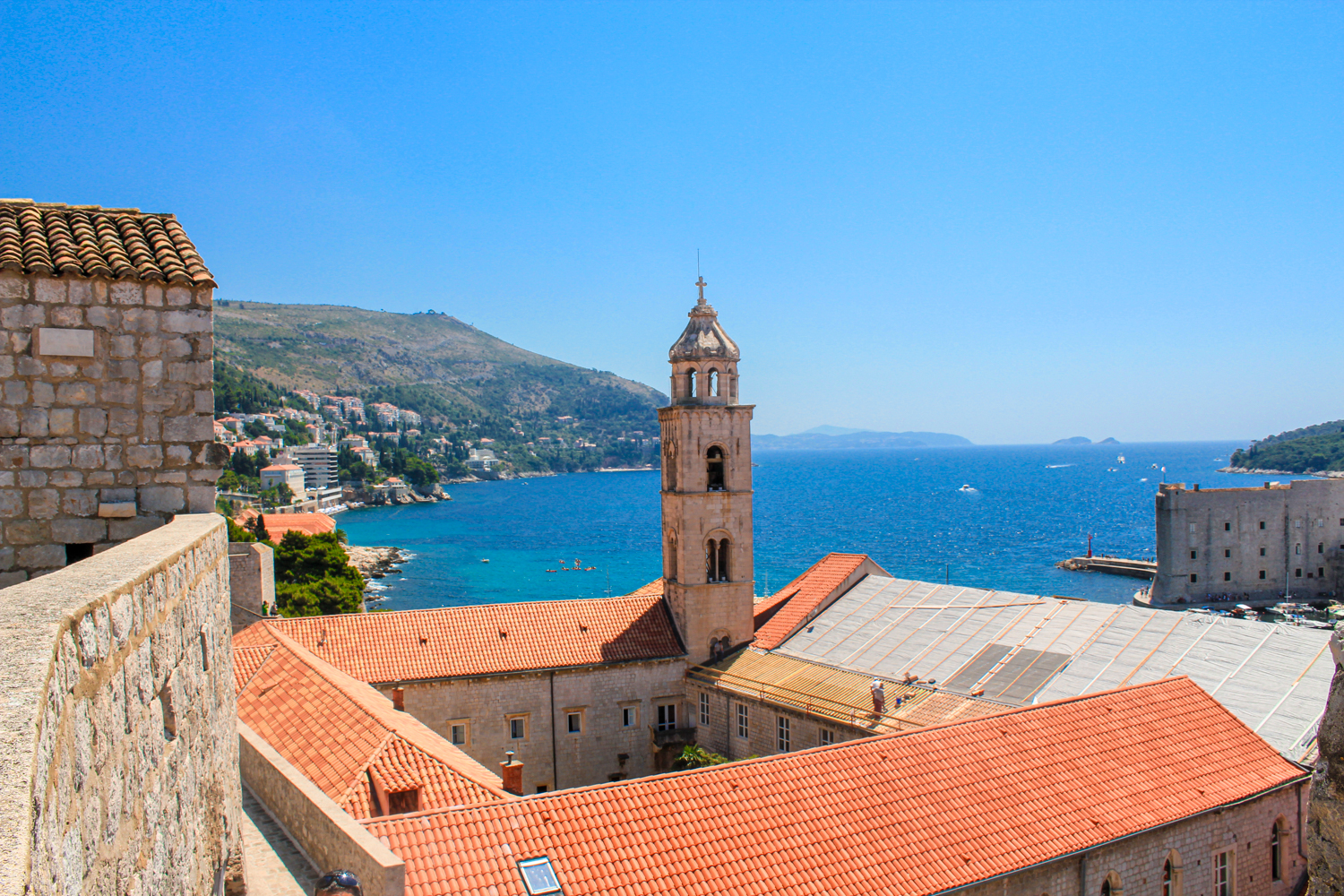
Known for its iconic Gothic cloisters and paintings from the 15th century, exploring the Dominican Monastery is one of the best things to do in Dubrovnik. When construction for the monastery began in the 1300s, the plans were so large that the walls had to be rearranged.
After the tragic earthquake in 1667, the Dominican Monastery rebuilt from the ground up, providing the monastery with its renowned cloister. Within the monastery is a museum full of paintings in 15th and 16th century Dubrovnik-style, plus golden and silver relics.
With fewer crowds than the more popular Franciscan Monastery, you can enjoy a peaceful experience in such a beautiful location. After visiting the museum, sit in the courtyard and take in the sounds of singing birds along with the pitter patter of the community beyond the walls.
Related Articles on Croatia
💰 The Cost of Travel in Croatia: My Detailed Budget Breakdown
🧳 How to Pack for a Trip to Croatia
🇭🇷 20 Best Things to Do in Zagreb, Croatia




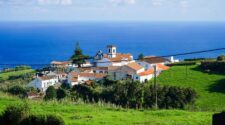
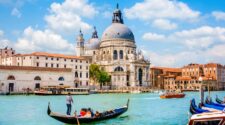

No Comment